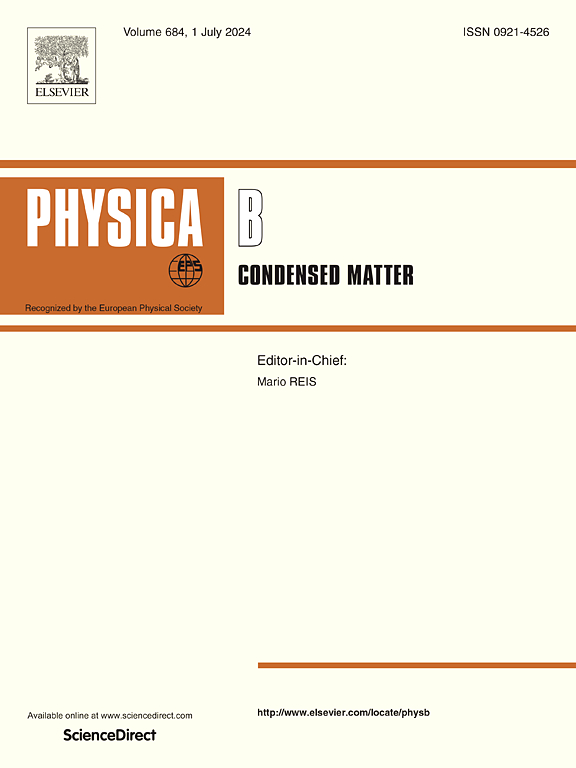Role of rGO reinforced Er-WO3 in biological, photocatalytic, luminescence and forensic applications
IF 2.8
3区 物理与天体物理
Q2 PHYSICS, CONDENSED MATTER
引用次数: 0
Abstract
The advancement of multifunctional heterostructured nanocomposites has garnered significant attention due to their promising applications. In this study, multifunctional WO3, Erbium-doped WO3 (Er-WO3), and Er-WO3/reduced graphene oxide (Er-WO3/rGO) composites were synthesized using the solution combustion method, with Jamaican cherry (Muntingia calabura) fruit juice serving as a bio-template. The structural, optical, and morphological properties of the synthesized nanomaterials were characterized through Fourier-transform infrared spectroscopy (FTIR), powder X-ray diffraction (PXRD), and ultraviolet–visible diffuse reflectance spectroscopy (UV-DRS), Raman spectroscopy, scanning electron microscopy (SEM), energy-dispersive X-ray spectroscopy (EDX), and transmission electron microscopy (TEM). The photocatalytic efficiency of the materials in dye degradation was investigated, revealing that Er-WO3/rGO exhibited superior performance compared to its undoped and doped counterparts, achieving a 94.9 ± 4.75 % degradation of Methylene Blue (MB) dye within 150 min. The photoluminescence spectra of Er-WO3/rGO demonstrated efficient charge carrier separation. Furthermore, Er-WO3/rGO facilitated the visualization of latent fingerprints, displaying well-defined ridge patterns with high resolution. Antibacterial activity assessments against Escherichia coli and Staphylococcus aureus revealed inhibition zones of 13.66 ± 1.15 mm and 14.33 ± 0.57 mm, respectively, following 12 h of incubation. Additionally, Er-WO3 and Er-WO3/rGO exhibited antioxidant activity against DPPH (2, 2-diphenyl-1-picrylhydrazyl) free radicals, with IC50 values of 4899 μg/mL and 4000 μg/mL, respectively. The incorporation of Erbium (Er) into the WO3 crystal lattice led to a reduction in crystallite size and bandgap energy, enhancing its functional properties. Meanwhile, the inclusion of rGO contributed to increased porosity and electrical conductivity, further promoting charge separation within the photocatalyst. Overall, this study introduces a novel approach for the development of multifunctional Er-WO3/rGO nanohybrids, highlighting their potential for applications in photoluminescence, latent fingerprint detection, photocatalytic dye degradation, antibacterial activity, and antioxidant functionality.
氧化石墨烯增强铒wo3在生物、光催化、发光和法医应用中的作用
多功能异质结构纳米复合材料因其广阔的应用前景而备受关注。本研究以牙买加樱桃(Muntingia calabura)果汁为生物模板,采用溶液燃烧法合成了多功能WO3、掺铒WO3 (Er-WO3)和Er-WO3/还原氧化石墨烯(Er-WO3/rGO)复合材料。通过傅里叶变换红外光谱(FTIR)、粉末x射线衍射(PXRD)、紫外-可见漫反射光谱(UV-DRS)、拉曼光谱、扫描电子显微镜(SEM)、能量色散x射线光谱(EDX)和透射电子显微镜(TEM)对合成纳米材料的结构、光学和形态特性进行了表征。研究了材料在染料降解中的光催化效率,发现Er-WO3/rGO表现出优于未掺杂和掺杂的材料的性能,在150 min内对亚甲基蓝(MB)染料的降解率为94.9±4.75%。Er-WO3/rGO的光致发光光谱显示出有效的载流子分离。此外,Er-WO3/rGO促进了潜在指纹的可视化,显示出清晰的山脊图案,分辨率高。对大肠杆菌和金黄色葡萄球菌的抑菌活性测定显示,12 h后,其抑菌带分别为13.66±1.15 mm和14.33±0.57 mm。此外,Er-WO3和Er-WO3/rGO对DPPH(2,2 -二苯基-1-苦味肼基)自由基具有抗氧化活性,IC50值分别为4899 μg/mL和4000 μg/mL。铒(Er)掺入WO3晶格后,晶粒尺寸减小,带隙能减小,功能性能增强。同时,还原氧化石墨烯的加入增加了孔隙度和导电性,进一步促进了光催化剂内部的电荷分离。总之,本研究介绍了一种开发多功能Er-WO3/rGO纳米杂化物的新方法,强调了它们在光致发光、潜在指纹检测、光催化染料降解、抗菌活性和抗氧化功能方面的应用潜力。
本文章由计算机程序翻译,如有差异,请以英文原文为准。
求助全文
约1分钟内获得全文
求助全文
来源期刊

Physica B-condensed Matter
物理-物理:凝聚态物理
CiteScore
4.90
自引率
7.10%
发文量
703
审稿时长
44 days
期刊介绍:
Physica B: Condensed Matter comprises all condensed matter and material physics that involve theoretical, computational and experimental work.
Papers should contain further developments and a proper discussion on the physics of experimental or theoretical results in one of the following areas:
-Magnetism
-Materials physics
-Nanostructures and nanomaterials
-Optics and optical materials
-Quantum materials
-Semiconductors
-Strongly correlated systems
-Superconductivity
-Surfaces and interfaces
 求助内容:
求助内容: 应助结果提醒方式:
应助结果提醒方式:


